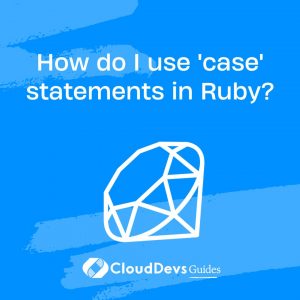How do I use ‘case’ statements in Ruby?
In Ruby, the `case` statement, also known as a switch statement in other programming languages, is used to evaluate a value against a series of possible conditions and execute code based on the first matching condition. It provides a clean and efficient way to handle multiple branches of conditional logic. Here’s how to use the `case` statement in Ruby:
- Basic `case` Statement: The basic structure of a `case` statement consists of the `case` keyword, followed by the expression you want to evaluate (usually a variable), and then a series of `when` clauses that specify possible conditions. Each `when` clause contains a condition to match against the expression and a block of code to execute if the condition is true. The `else` clause is optional and serves as a fallback for when none of the conditions match.
```ruby grade = 'B' case grade when 'A' puts "Excellent!" when 'B' puts "Good job!" when 'C' puts "You passed." else puts "Needs improvement." end ```
In this example, the `case` statement evaluates the value of `grade` and executes the code block associated with the first matching condition, which is `’B’`. It will output “Good job!”
- Using Ranges: You can use ranges in `when` clauses to match values within a specific range. This is particularly useful for evaluating numeric or character ranges.
```ruby score = 85 case score when 90..100 puts "A" when 80..89 puts "B" when 70..79 puts "C" else puts "F" end ```
In this example, the `case` statement uses ranges to determine the grade based on the `score`.
- Using `then` for One-Liners: You can use `then` to write one-liner code for `when` clauses when the code is short and concise.
```ruby fruit = 'apple' case fruit when 'apple' then puts "It's an apple." when 'banana' then puts "It's a banana." else puts "It's something else." end ```
The `case` statement in Ruby provides a clean and organized way to handle multiple conditions, making your code more readable and maintainable. It’s especially useful when you have a value to compare against several possible options. The `case` statement evaluates conditions sequentially and executes the first matching block of code, offering a versatile tool for branching logic in your Ruby programs.







